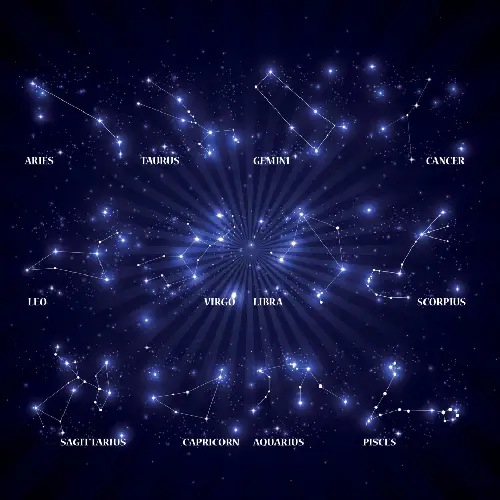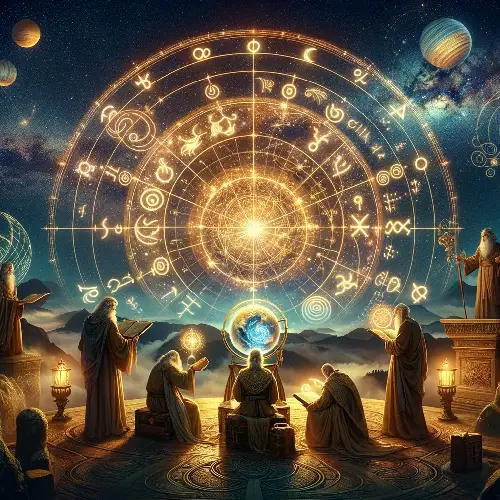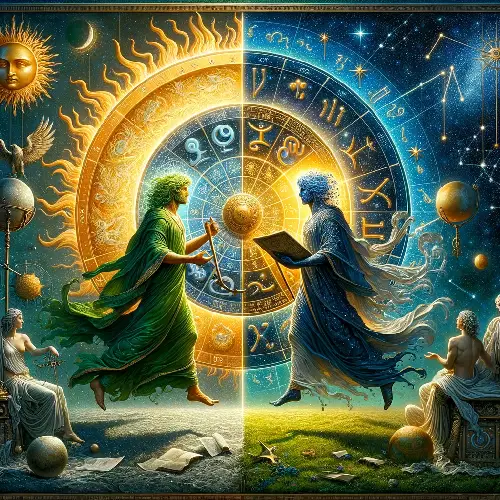Overview
In Vedic astrology, Nakshatra refers to the lunar mansion where the Moon resides for approximately one day, making each mansion about 13°20′ long. These Nakshatras are further divided into four quarters known as Padas, each spanning around 3°20′ in length.
According to Vedic astrology, Nakshatras, or lunar constellations, form a connection with the Moon’s natal symbols. The Moon spends about 2.3 days in each zodiac sign, taking a total of 28 days to traverse the entire zodiac. As the ruler of Nakshatras, the Moon governs planetary positions and influences the diverse paths of individual lives.
Nakshatras hold significant importance in astrology, with their name originating from “Naksha,” meaning map, and “Tara,” signifying star, depicting the celestial map they create. The Rig Veda marks the earliest mention of Nakshatras, while the Yajurveda and Atharva Veda provide comprehensive lists of the 27 constellations, showcasing their enduring role in human understanding of the cosmos.
How to know Your Nakshatra?
To determine your Nakshatra, you’ll need precise birth information your exact date of birth including the year, the place of birth, and the precise time. Once you provide these details to an astrologer, they can easily ascertain the Moon’s position at the time of your birth and identify the Nakshatra you belong to.
Your Nakshatra is determined by the location of the Moon at the moment of your birth. Additionally, your horoscope plays a crucial role, offering further insights into the positions of the Sun and Moon during your birth. Understanding these elements provides a comprehensive understanding of your well-being, characteristics, and more.
The Mythical Legend of the Nakshatras
In Hindu mythology, the tale unfolds with King Dakshan, who was blessed with 27 daughters, symbolizing the Nakshatras. The Moon, enamored by their beauty, wed all 27 daughters, but his heart favored Rohini, known as the exaltation point of the Moon in astrology. Unhappy with this partiality, the other 26 wives lodged complaints with the King, but the Moon remained unchanged, invoking the King’s ire.
In his anger, King Dakshan cursed the Moon, causing it to diminish in size, leading to its waning. Witnessing the repercussions, the other deities pleaded with the King to revoke his curse. In response, the King agreed, stipulating that the Moon must spend equal time with each daughter to appease their grievances. Though unable to fully lift the curse, the King provided a remedy, stating that the Moon would regain strength halfway through each month.
Thus, the cycle of Purnima (full moon) and Amavasya (new moon) emerged, with the Moon spending equal time in each Nakshatra, completing its zodiacal journey within the lunar month.
Divisions within Nakshatras: Understanding Padas
Among the 27 constellations, each is divided into four parts called Padas, which exhibit traits reminiscent of the zodiac signs, commencing with Aries. This integration of Padas with the zodiac signs forms a fundamental aspect of Nakshatras’ structure.
Within every trio of constellations, comprising three Nakshatras, there exist 12 Padas. Each Pada represents one of the zodiac signs, resulting in a comprehensive portrayal of all the zodiac signs through the Padas.
Given that each zodiac sign encompasses roughly 2.25 parts of the zodiac, the count of Padas totals to 4 + 1, equating to 9 Padas in total. Padas offer insights into the individual’s soul and hold significance akin to that of a zodiac sign.
Traits of Nakshatra
Symbolism: Each nakshatra is associated with a particular symbol, which could be an animal, deity, or object. These symbols reflect the essence and qualities of the nakshatra.
Ruling Planet: Each nakshatra is ruled by a specific planet or planetary deity, which contributes to its overall energy and influences the areas of life it governs.
Guna (Quality): Nakshatras are categorized into three gunas: Sattva (purity), Rajas (activity), and Tamas (inertia). This classification indicates the predominant quality of energy associated with the nakshatra.
Element: Nakshatras are also associated with specific elements such as fire, earth, air, or water, which further define their nature and characteristics.
Doshas and Yogas: Nakshatras may indicate the presence of doshas (flaws or imbalances) or yogas (auspicious combinations) in a person’s birth chart, which can influence their karma and life experiences.
Temperament: Nakshatras exhibit different temperaments, ranging from fiery and dynamic to calm and nurturing. This temperament influences the behavior and approach of individuals born under the nakshatra.
Purpose and Motivation: Each nakshatra is believed to have a specific purpose or motivation that drives individuals towards certain experiences, lessons, or achievements in life.
Impact on Life Events: The placement of planets in specific nakshatras can influence significant life events, relationships, and career paths. Different nakshatras govern different aspects of life, and their influence can be seen in various areas of a person’s chart.
Sex: Nakshatras are classified into two categories based on the gender: masculine and feminine
- Masculine Nakshatras: These nakshatras are associated with assertive, active, and outwardly expressive qualities. Here are a few nakshatras that are considered masculine Ashwini, Mrigashira, Mula, Magha, Purvaphalguni, Purvasadha etc.
- Feminine Nakshatras: Feminine nakshatras are characterized by nurturing, receptive, and inwardly reflective qualities. Here are a few nakshatras that are considered feminine – Rohini, Hasta, Swati, Anuradha, Revati etc.
Temperament: Nakshatras have distinct temperaments that influence their behavior and approach to life.
Some nakshatras may be fiery and dynamic, while others could be calm and serene.
Temperaments can vary based on the ruling planet and elemental influences associated with each nakshatra. Furthermore, there are 3 main sub-categories to it which are listed below :
- Deva Nakshatras: Deva nakshatras are associated with divine qualities, spirituality, and higher consciousness. They reflect virtues such as compassion, generosity, and altruism.
- Manushya Nakshatras: Manushya nakshatras are aligned with human qualities and experiences. They represent the human condition, growth, and evolution.
- Rakshasa Nakshatras: Rakshasa nakshatras embody primal instincts, challenges, and intensity. They signify raw power, ambition, and the struggle between light and darkness.
Animal Symbolism: Each nakshatra is associated with an animal symbol that represents its energy and characteristics.
- Animal symbols range from mythical creatures to real animals, each carrying symbolic significance.
- For example, the nakshatra Ashwini is symbolized by a horse, representing swiftness and vitality.
Guna: In Vedic astrology, nakshatras are also classified based on the three gunas or qualities: Sattva, Rajas, and Tamas. These gunas represent different aspects of consciousness and influence the nature and attributes of each nakshatra. Here’s how the nakshatras are categorized based on the guna characteristic:
- Sattva: Nakshatras with a predominance of sattva guna are associated with purity, harmony, and spiritual growth.
- Rajas: Rajasic nakshatras exhibit qualities of passion, activity, and ambition, driving individuals towards material pursuits.
- Tamas: Nakshatras influenced by tamasic guna may reflect qualities of lethargy, inertia, and darkness.
What makes Nakshatras different from Zodiac Signs?
Zodiac signs divide the sky into twelve parts, while Nakshatras divide it into 27 equal divisions. Each Zodiac sign covers a 30° zone within the 360° circle, whereas each Nakshatra spans approximately 13.33°. Essentially, Nakshatras constitute smaller segments within the twelve Zodiac signs of astrology. Thus, roughly 2.25 parts of each Nakshatra fall within each Zodiac sign, from Aries to Pisces.
The Four Aims of Life and their Connection to Nakshatras
Life encompasses four aims Dharma, Artha, Kama, and Moksha. By examining the Nakshatra’s position among the planets, one can discern an individual’s primary life aim.
- Dharma delineates one’s actions and duties, reflecting the soul’s fulfillment through daily endeavors.
- Artha pertains to wealth and sustenance, ensuring fulfillment of basic needs like food and shelter.
- Kama signifies the pursuit of desires, reflecting one’s aspirations and passions.
- Moksha represents the liberation of the soul, symbolizing ultimate spiritual freedom.
Interestingly, each aim of life aligns with an elemental aspect in astrology: Dharma correlates with fire, Artha with earth, and Kama and Moksha with water.
The Significance of Nakshatras in Astrology
In Vedic astrology, the analysis of Nakshatras holds immense importance as it reveals insights into how individuals perceive and understand life. Additionally, Nakshatras aid in determining the Dasha period in one’s horoscope.
Here are some key points highlighting the importance of Nakshatras in astrology:
- Astrologers rely on Nakshatra readings for accurate predictions and detailed analysis. Nakshatras, associated with zodiac signs and ruling deities, unveil various traits and characteristics of individuals.
- Each Nakshatra possesses unique power and energy attributed to the nine lords in astrology, which influences astrological interpretations significantly.
- Nakshatras serve as indicators of the abodes where the consequences of our actions (Karmas) are stored and distributed.
- Understanding an individual’s traits and discerning the key points of their aspirations and energy is facilitated by Nakshatras.
- In Kundli matching, Nakshatras play a pivotal role as astrologers assess the compatibility between couples and predict the future prosperity of their married life.
In essence, Nakshatras serve as essential components in astrological analyses, offering valuable insights into various aspects of an individual’s life and destiny.
Understanding the characteristics of nakshatras is essential for astrologers to interpret birth charts accurately and provide insights into an individual’s personality, strengths, challenges, and life trajectory based on the positions of these lunar constellations.


